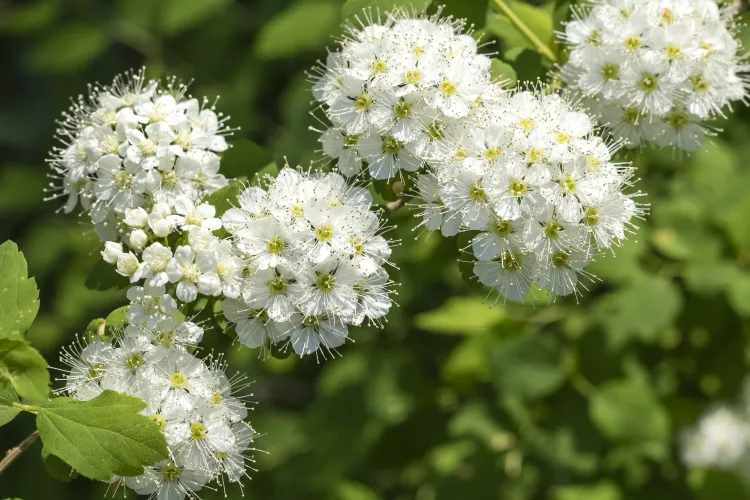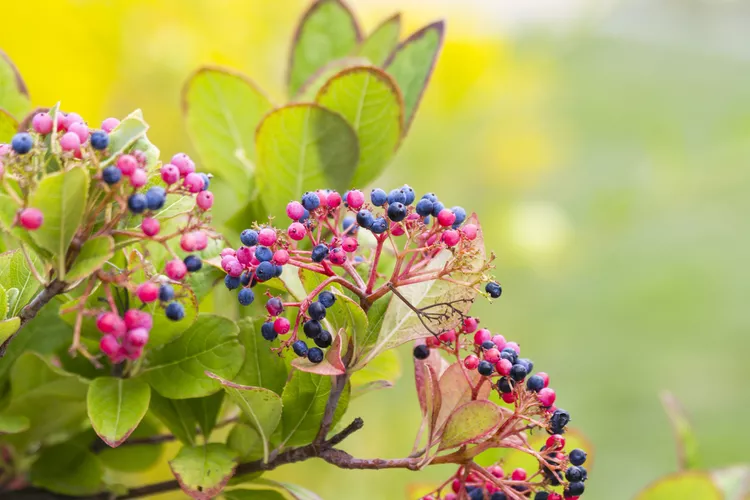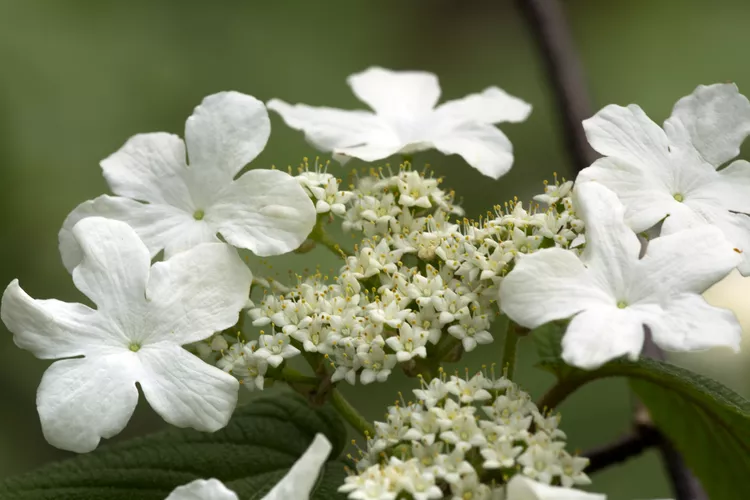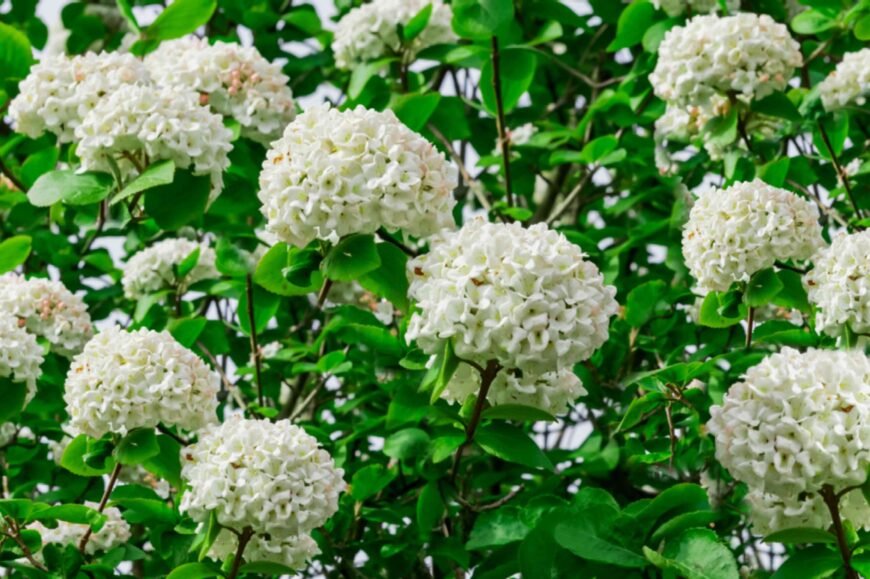| Common Name | Viburnum, American cranberry bush, hobblebush |
| Botanical Name | Viburnum spp. |
| Family | Adoxaceae |
| Plant Type | Shrub |
| Mature Size | 3-20 ft. tall, 3-12 ft. wide |
| Sun Exposure | Full, partial |
| Soil Type | Moist, well-drained |
| Soil pH | Neutral, acidic |
| Boom Time | Spring |
| Flower Color | White, pink |
| Hardiness Zone | 2-9 (USDA) |
| Native Area | North America |
Viburnum Care
Once established, viburnum plants are fairly low-maintenance. Here are the main care requirements for growing viburnum:
- Plant viburnum in early spring, in a location with full sun.
- Prepare rich, well-draining soil that retains some moisture.
- Water weekly whenever it hasn’t rained.
- Prune any leggy growth after blooming, if desired.
- Apply a balanced fertilizer each spring.
Planting
Choose a location that receives plenty of sunlight with well-draining soil. The best time to transplant is typically in spring. Leave about four feet between each plant.
To plant viburnum, dig a hole as deep as the container and twice as wide. Gently remove the plant from the container and place it in the center of the hole. Backfill the hole halfway, add some water, then fill the hole completely.
After planting, add a 2-inch layer of mulch to help the soil hold in moisture. During hot weather, the shrubs should be watered every 7 to 10 days. Little pruning is necessary, though some species can be trained to form tree-like plants by removing competing stems.
Light
Viburnums prefer full sun but will tolerate part shade. In fact, some afternoon shade is desirable in the warmer zones of the plant’s hardiness range. Some varieties, like blackhaw viburnum, are particularly well-suited to partial shade.
Soil
These shrubs prefer fairly moist, well-drained soil, but they do not like to have their roots soaking in water. Viburnums like slightly acidic soil but many types will tolerate alkaline soil.
Water
A deep watering every week is usually sufficient, either through rainfall or irrigation. Native varieties that are well-established have a fairly good drought tolerance.
Temperature and Humidity
Viburnums prefer moderate conditions, though the preferences vary greatly depending on the species. Extremely hot weather requires extra watering, and very cold temperatures can stunt the plant or cause dieback.
Though there is variety within species, some are perennial down to zone 2, where winter temperatures reach the negative range.
Fertilizer
Most viburnums need little more than one application each year of a balanced, time-release fertilizer mixed into the soil in spring. For the amount, follow the product label instructions. Once established, most shrubs do well without any feeding.
Types of Viburnum
This large group of plants includes deciduous, semi-evergreen (may shed their leaves for a short time in the cooler months), and evergreen shrubs and small trees. Certain types can be deciduous or evergreen, depending on the area in which the plant grows.
Viburnum flower colors are usually white or sometimes pink, and the deciduous foliage can turn red or maroon in the fall. There’s also a huge size range within viburnums, ranging from a height of two to 30 feet.
Deciduous Viburnums
- Arrowwood viburnum (V. dentatum): This deciduous shrub reaches up to 10 feet in height and has 4-inch clusters of white flowers followed by blue fruits.
- Snowball viburnum (V. plicatum): This shrub has fluffy, white flower clusters that look like snowballs. There are two different forms, Japanese snowball bush and doublefile viburnum.
- Korean spice viburnum (V. carlesii): This popular flowering shrub is aromatic with pink buds that turn into clusters of white flowers with early pink color in the spring. Fall leaves turn red to purple, though sometimes orange, before falling.
- Wayfaring tree (V. lantana): This is a viburnum shrub that grows vigorously with white flowers that are followed by red fruits.
- Burkwood viburnum (Viburnum x burkwoodii): This hybrid is adaptable to many soil types and can withstand extreme heat and drought.
- Mohawk viburnum (Viburnum × burkwoodii ‘Mohawk’): This cultivar has dark red flower buds and flowers with a strong, spicy fragrance.
- Mapleleaf viburnum (V. acerifolium): This shrub reaches about six feet high and can handle more shade than other species in its genus.
Evergreen Viburnums
- Sweet viburnum (V. odoratissimum): This evergreen can be grown as a shrub or small tree, reaching up to 20 feet, and is somewhat drought-tolerant.
- Walter’s viburnum (V. abovatum): This native evergreen reaches 20 feet tall and is best for warmer climates (USDA zones 7-10). White flowers appear in the spring.

Nannyberry


Pruning
Prune viburnum with sharp pruners. Leggy shoots can be trimmed back in early summer to maintain the shrub’s form. As viburnum blooms on old wood, pruning should be undertaken only after the bloom period.
Broken, dead, or diseased branches should be removed as soon as you notice them. Tree forms of this plant may require some pruning to achieve the desired shape.
Propagating Viburnum
You can propagate viburnum from softwood or hardwood cuttings with growth nodes. For softwood cuttings, choose a vigorous branch of four to six inches in length. Remove leaves from the lower third. For hardwood cuttings, choose a strong stem and cut eight to 10 inches of it, stripping the leaves from the bottom half and making sure to include at least a few nodes.
Fill small pots with a moist mixture of peat and perlite. Dip the stems in rooting hormone. Plant the cutting in the pot. Cover the cutting with a plastic bag or dome and keep it in indirect light, with damp soil, until the roots begin to form in about four weeks for a softwood cutting.
Potting and Repotting Viburnum
Carefully choose your cultivar for planting in pots; some types of viburnum must have the space an outdoor planting provides, while others are ideal for smaller habitats.
Plant the viburnum in large containers with drainage holes. The pot should be at least eight inches wider than the root ball. This plant needs well-draining soil and full sun. To avoid soggy soil, add 10 to 20 percent perlite to the mix.
Overwintering
Viburnum is hardy but might drop leaves in colder weather. Prune off dead leaves and branches. Come spring, your shrub will recover. In mild winters, semi-evergreen viburnums will maintain some or all of their foliage.
Common Pests
The fact that few pests bother viburnums is one of the reasons they have become so popular in the landscape. However, the viburnum leaf beetle can be a problem. This pest is capable of great damage and is being closely watched. The best way to combat viburnum leaf beetles is to remove egg-infested leaves and encourage predatory insects.
Viburnums may struggle with aphids as well. Some organic pesticides are also effective, but avoid synthetic pesticides, which also kill beneficial insects.
How to Get Viburnum to Bloom
Viburnums often bloom from early spring to late summer. If your viburnum is not blooming, look at the location—though it can handle some shade, those kept in full sun will form blooms more readily.
Watering might also be an issue, as viburnum needs to be in well-drained soil. Remember that too much nitrogen can encourage lush foliage but stunt the explosion of blooms. Since the plant blooms on old wood, don’t trim them during dormancy, as this will eliminate the bloom-producing buds.
Common Problems with Viburnum
Fortunately, viburnum has few issues for gardeners to contend with. However, if you notice any of the following, treat the problem immediately to ensure the health of your plant.
Black Spots or White Growth on Leaves
This is often the result of a fungal disease, such as powdery mildew, downy mildew, or fungal leaf spots. To prevent this, avoid watering the plants from overhead, use a fungicide on affected plants, and destroy parts of the plant that are already affected.
Stunted or Yellow Leaves
This might be the result of Armillaria root rot, which can be determined by a white fungal growth under the bark and at the crown of the tree or shrub. If this problem has made its way into the trunk, the only solution is to dig up and discard the viburnum.
Dead, Wilted, and Discolored Leaves
Viburnum could be affected by canker, which is a fungal problem. This often occurs with trees that are already stressed. The most effective treatment is restoring the plant to health, as it can likely fight off this particular issue on its own.
-
-
There are many species and cultivars of viburnum with different light requirements. Generally, viburnums prefer full sun but many can handle partial shade.
-
-
-
Viburnums and hydrangeas are both flowering shrubs, but they are not the same plant. In fact, they are not even in the same plant family.
-
-
-
Some species of viburnum are evergreen or semi-evergreen, maintaining their foliage through the winter. This is not the case for all viburnum species.
-
